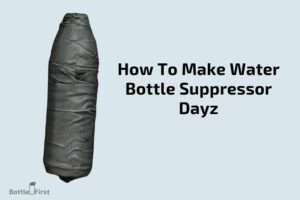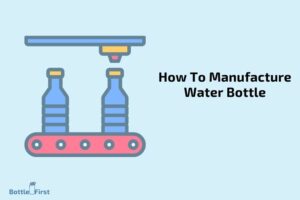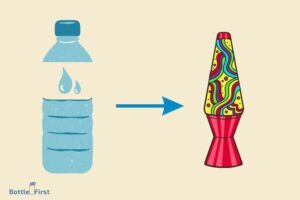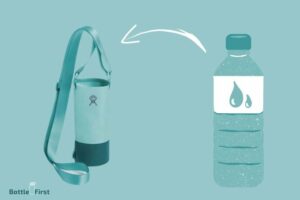How to Tell If a Water Bottle is Bpa Free? 8 Easy Steps!
To determine if a water bottle is BPA free, check out the recycling symbol on the bottom of the bottle. If there’s a number “7” within the recycle symbol, there’s a chance it’s made with BPA.
However, if you see the number “1”, “2”, “4” or “5”, it is BPA free. Many manufacturers also specify if their products are BPA free on the label or packaging.
BPA, or bisphenol A, is a chemical used in the production of certain plastics, including some water bottles. However, research has raised concerns about the potential health impacts of BPA, leading many manufacturers to produce BPA-free products.
Always check your water bottle for recycling symbols or labels indicating whether it is BPA-free.
Remember that while a “7” doesn’t automatically mean the bottle contains BPA, it does mean there’s a chance it could.
Opting for products clearly labeled “BPA-free” is the safest choice for those seeking to avoid this chemical.
8 Steps: Identifying BPA-Free Water Bottles
| Steps | Description |
|---|---|
| 1 | Check the Bottle’s Bottom |
| 2 | Look for a plastic code |
| 3 | Identify if the code is “7” |
| 4 | Look for BPA-Free Label |
| 5 | Check the Material Description |
| 6 | Investigate the Brand |
| 7 | Contact the Manufacturer |
| 8 | Look for Discoloration or Residue |
Key Takeaway
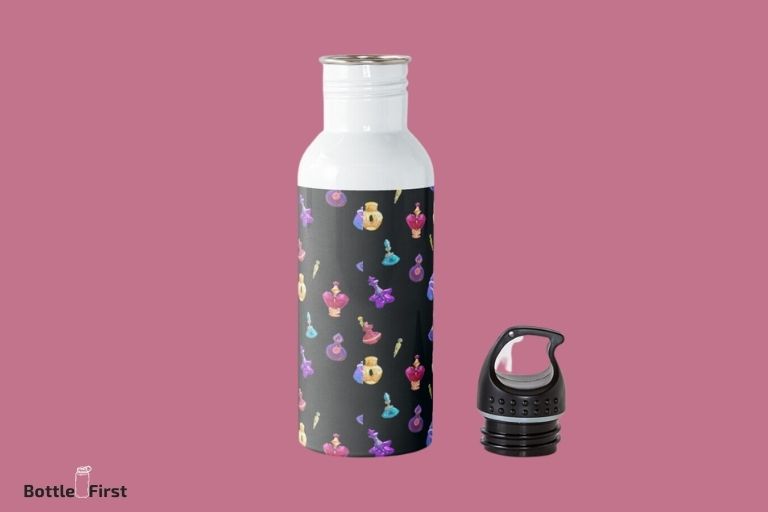
Five Facts About: Water Bottle is BPA Free
Understanding Bpa And Its Impact On Health
Bpa, or bisphenol a, is a chemical compound commonly used in the production of plastics and resins. It is widely used in the manufacturing of food and beverage containers, including water bottles.
However, in recent years, there has been growing concern about the potential health risks associated with bpa exposure.
In this section, we will delve into what exactly bpa is and why it is a concern. We will also explore the potential health risks associated with bpa exposure and highlight the importance of choosing bpa-free water bottles.
What Is Bpa And Why Is It A Concern?
- Bpa is a compound used in the production of plastics, including polycarbonate plastics and epoxy resins.
- Polycarbonate plastics often used in water bottles can release bpa into the liquids they contain.
- Bpa can also be found in other commonly used products such as food storage containers, baby bottles, and dental materials.
- The concern surrounding bpa arises from its ability to mimic the hormone estrogen in the body, leading to potential hormonal disturbances.
- The estrogenic properties of bpa raise concerns about its potential impact on human health, particularly when it comes to hormonal balance and development.
The Potential Health Risks Associated With Bpa Exposure
- Research has shown that bpa has the potential to disrupt the endocrine system, which plays a crucial role in regulating various bodily functions.
- Studies have linked bpa exposure to adverse effects on reproductive health, including reduced fertility, developmental issues in fetuses and infants, and hormonal imbalances.
- Bpa has also been associated with an increased risk of certain health conditions such as breast and prostate cancer, obesity, cardiovascular disease, and diabetes.
- It is important to note that the extent of the health risks associated with bpa exposure is still being studied, and more research is needed to fully understand the long-term effects.
The Importance Of Choosing Bpa-Free Water Bottles
- Opting for bpa-free water bottles is a proactive step towards reducing your exposure to this potentially harmful chemical.
- Bpa-free water bottles are made from alternative materials that do not contain bpa or other harmful chemicals.
- By choosing bpa-free water bottles, you can minimize the risk of bpa leaching into your drinking water and potentially disrupting hormonal balance.
- Bpa-free water bottles are widely available and come in various materials such as stainless steel, glass, and bpa-free plastics.
- When purchasing a water bottle, look for labels or certifications indicating that it is bpa-free.
- Choosing bpa-free water bottles is especially important for infants, young children, and pregnant individuals, as they may be more susceptible to the potential health risks associated with bpa exposure.
By understanding the concerns surrounding bpa and its potential impact on health, you can make informed choices when it comes to selecting water bottles that are bpa-free.
Prioritizing your health and well-being by choosing bpa-free options can contribute to a safer and healthier lifestyle.
Examining The Label And Packaging
When it comes to choosing a water bottle that is free from harmful bpa (bisphenol a), examining the label and packaging is crucial.
By understanding the key information to look for on the label, the bpa-free certifications and seals, as well as how to interpret various recycling codes, you can ensure that the water bottle you choose is truly bpa-free.
Let’s dive into these important factors:
Key Information To Look For On The Label:
- Look for the “bpa-free” statement prominently displayed on the label. This indicates that the water bottle is free from bpa.
- Check for additional claims such as “non-toxic” or “safe for health.” These claims provide added assurance of the bottle’s safety.
- Take note of the material used to make the bottle. Opt for materials like stainless steel, glass, or bpa-free plastics, such as tritan or hdpe (high-density polyethylene). These materials are known to be free from bpa.
Understanding Bpa-Free Certifications And Seals:
- Look for certifications from reputable organizations like the fda (food and drug administration) or nsf (national sanitation foundation). These certifications ensure that the water bottle has undergone rigorous testing and meets strict safety standards.
- Familiarize yourself with specific bpa-free seals, such as the “bpa-free” symbol or label. These seals indicate that the bottle has been certified to be free from bpa.
- Be cautious of misleading symbols or claims that may mimic genuine bpa-free seals but are not backed by recognized organizations. Always look for reputable certifications or seals.
How To Interpret Various Recycling Codes:
- Pay attention to the recycling codes found on the bottom of the water bottle. These codes, represented by a number within a triangle of arrows, provide valuable information about the type of plastic used.
- Look for the recycling code #7, which indicates that the bottle is made from a bpa-containing plastic. It is best to avoid bottles with this code if you want to ensure bpa-free drinking.
- Seek out recycling codes #1, #2, #4, and #5, as these indicate the use of bpa-free plastics like pet (polyethylene terephthalate), hdpe, ldpe (low-density polyethylene), or pp (polypropylene).
By carefully examining the label and packaging of a water bottle, you can make an informed decision about its bpa-free status.
Remember to look for key information on the label, understand bpa-free certifications and seals, and interpret various recycling codes.
With this knowledge, you can confidently choose a water bottle that is safe and free from bpa.
Identifying Bpa-Free Materials
Plastic water bottles have become a ubiquitous part of our daily lives, but concerns about the potentially harmful chemical compound called bisphenol a (bpa) have led many of us to search for safer alternatives. So how can you tell if a water bottle is bpa-free?
One way is by understanding the different materials used in water bottle production and which ones are typically bpa-free. Let’s dive into it.
Introduction To Different Materials Used In Water Bottles
When it comes to water bottle materials, not all are created equal. Different types of plastics, as well as stainless steel and glass, are commonly used in the manufacturing of water bottles.
Here are the key materials you need to be familiar with:
- Plastic: The most commonly used material in water bottles is plastic. However, not all plastics are created equal, and not all of them are bpa-free. It’s important to know the specific type of plastic used in a water bottle before determining if it’s bpa-free.
- Stainless steel: Stainless steel has gained popularity as a durable and bpa-free option for water bottles. It is also known for its ability to retain the temperature of the contents, keeping liquids cold or hot for extended periods.
- Glass: Glass water bottles offer a clean, non-toxic, and eco-friendly option for those concerned about potential chemical leaching. However, they can be more fragile and heavier compared to plastic or stainless steel bottles.
Which Materials Are Typically Bpa-Free?
While the presence of bpa often depends on the specific type of plastic used, some materials are more likely to be free from this harmful chemical compound.
Here are the materials that are typically bpa-free:
- Tritan: Developed as a bpa-free alternative, tritan is a durable plastic that is commonly used in water bottles. It offers the clarity of glass, the lightweight nature of plastic, and excellent resistance to odors and stains.
- Polypropylene (pp): Another bpa-free plastic, polypropylene, is a popular choice for water bottles due to its excellent durability and heat resistance.
- Stainless steel: As mentioned earlier, stainless steel is a material known for its bpa-free properties. It is an ideal choice for those who prefer a long-lasting and safe option.
Tips For Identifying Bpa-Free Bottles Based On Material
Now that you are familiar with the different materials used in water bottles and which ones are typically bpa-free, here are some practical tips to help you identify bpa-free bottles based on their material:
- Look for labels or product descriptions that specifically mention “bpa-free” or “bisphenol a-free.” This ensures that the manufacturer has specifically designed the bottle to be free from this harmful chemical.
- Check the recycling symbol at the bottom of the bottle. Codes 1, 2, 4, and 5 are generally considered safe and bpa-free. Avoid bottles with code 7, as it may contain bpa.
- If you prefer stainless steel bottles, make sure they are made from food-grade stainless steel (usually labeled as 18/8 or 304 stainless steel). This grade of stainless steel is safe and does not contain any harmful chemicals.
- Consider opting for glass water bottles if you prefer a plastic-free and environmentally friendly option. Ensure that the glass used is shatter-resistant and wrapped in a protective silicone sleeve for added durability.
By understanding the different materials used in water bottles, which ones are typically bpa-free, and following these tips, you can make informed choices that prioritize your health and well-being.
Remember, staying hydrated should never come at the expense of your safety.
Conducting A Simple Home Test
Step-By-Step Guide To Testing A Water Bottle For Bpa
When it comes to ensuring the safety of the water bottles we use, knowing whether they are bpa-free is crucial.
Bpa (short for bisphenol a) is a chemical that can potentially seep into our water and pose health risks if consumed in large amounts.
To ease your worries and determine if your water bottle is bpa-free, you can conduct a simple home test using the following steps:
- Fill the bottle with warm soapy water: Wash your water bottle thoroughly with warm soapy water, ensuring it is clean and free from any residue.
- Rinse the bottle with distilled water: Rinse the bottle with distilled water to remove any remaining soap or impurities that may affect the test results.
- Fill the bottle with boiling water: Boil a small amount of water and carefully pour it into the water bottle, ensuring the bottle is filled to its maximum capacity.
- Let it sit for a few minutes: Allow the boiling water to sit inside the bottle for a few minutes, as this increases the chances of detecting any bpa presence.
- Pour out the water and observe: Carefully pour out the boiling water and examine the interior of the bottle. Look for any noticeable changes or alterations in its appearance.
Tools And Supplies Needed For The Test
To perform this simple home test, you will need the following tools and supplies:
- Warm soapy water: Use mild dish soap to clean the water bottle thoroughly.
- Distilled water: This type of water is free from impurities, ensuring accurate test results.
- Boiling water: Boil a small amount of water to fill the water bottle for the test.
- Timer or clock: Use a timer or clock to keep track of the time during the test.
Interpreting The Results Of The Test
Now that you have conducted the simple home test, it’s time to interpret the results to determine if your water bottle is bpa-free.
Here are some key points to consider when examining the test outcome:
- No visible changes: If the bottle’s interior remains unchanged, with no alterations in color, texture, or odor, it is likely bpa-free.
- Changes in appearance: If you notice any discoloration, cloudiness, or unusual odor in the bottle, there may be a possibility of bpa presence. It is recommended to avoid using such bottles and opt for bpa-free alternatives.
- Repeated tests: If you are unsure about the initial results, try conducting the test multiple times to ensure accuracy.
Remember, this home test is not foolproof, and it’s always recommended to check if your water bottle is labeled as bpa-free by the manufacturer.
By following these steps and using the right tools, you can gain more confidence in the safety and quality of the water bottles you use.
Stay hydrated and stay safe!
Recognizing Bpa-Free Brands And Products
When it comes to purchasing a water bottle, it’s important to ensure that it is free from potentially harmful chemicals like bpa (bisphenol a).
Bpa is known to leach into beverages and can be hazardous to our health. To help you make an informed choice, here are some key points to consider when looking for bpa-free brands and products:
Overview of reputable brands known for bpa-free bottles:
- Nalgene: Nalgene is a well-known brand that offers a wide range of bpa-free water bottles. Their bottles are made of durable materials and are known for their quality and longevity.
- Klean kanteen: Klean kanteen is another trusted brand in the industry. They specialize in producing stainless steel water bottles that are free from harmful chemicals, including bpa.
- Camelbak: Camelbak is a popular brand that prioritizes the safety of their customers. They offer a variety of bpa-free water bottles designed for outdoor and everyday use.
Top recommendations for bpa-free water bottles on the market:
- Hydro flask: Hydro flask is known for its insulation capabilities and durability. They offer bpa-free stainless steel water bottles that can keep your beverages hot or cold for hours.
- Contigo: Contigo is a brand that focuses on creating spill-proof and leak-proof water bottles. Their bpa-free bottles are perfect for those always on the go.
- Lifefactory: Lifefactory is renowned for their glass water bottles with protective silicone sleeves. They offer bpa-free options for those who prefer glass over plastic.
Additional features to consider when choosing a bpa-free water bottle:
- Size and capacity: Consider the size and capacity of the water bottle to ensure it meets your hydration needs. Whether you prefer a smaller bottle for portability or a larger one for longer trips, choose the one that suits your lifestyle.
- Material: While bpa-free plastic is a popular choice, stainless steel and glass are also great alternatives. Stainless steel bottles are known for their durability and insulation properties, while glass bottles provide a clean and pure taste.
- Lid and cap design: Look for water bottles with leak-proof lids and easy-to-use caps. Some bottles come with straw lids or flip-top caps for convenient drinking on the go.
- Cleaning and maintenance: Consider how easy it is to clean and maintain the water bottle. Look for bottles that are dishwasher safe or come with wide openings for effortless cleaning.
Remember, choosing a bpa-free water bottle not only ensures your safety but also contributes to a healthier environment.
By opting for reputable brands known for their commitment to producing bpa-free products, you can confidently enjoy your hydrating experience while minimizing your exposure to harmful chemicals.
Can I Use BPA-Free Water Bottle Labels to Personalize My Water Bottles?
Personalizing water bottle labels in 7 steps allows you to create unique and customized water bottles. By using BPA-free water bottle labels, you ensure a safe and eco-friendly choice. With a variety of designs and materials available, you can add your personal touch to the bottles, making them perfect for events, parties, or as gifts.
FAQ About Tell If A Water Bottle Is Bpa Free
How Do I Know If A Water Bottle Is Bpa-Free?
To determine if a water bottle is bpa-free, look for labels indicating “bpa-free” or check the product description.
Are All Plastic Water Bottles Bpa-Free?
No, not all plastic water bottles are bpa-free. Some may still contain this chemical, so be sure to check for bpa-free labels.
What Are The Dangers Of Using A Water Bottle With Bpa?
Using a water bottle with bpa can potentially lead to hormone disruption and various health issues, especially when exposed to heat.
Can I Microwave A Water Bottle If It Is Bpa-Free?
Yes, if a water bottle is labeled as bpa-free, it is generally safe to microwave it. However, always check the instructions provided by the manufacturer.
How Long Do Bpa-Free Water Bottles Last?
The durability of bpa-free water bottles depends on various factors, such as usage and maintenance. However, they are designed to last for a long time if properly cared for.
Conclusion
After reading this comprehensive guide, you should now be equipped with the knowledge on how to determine if a water bottle is bpa-free.
Remember to look for the appropriate symbols and labels on the bottle to ensure it is free from harmful chemicals.
Checking for certifications and conducting research on reputable brands will give you added peace of mind when making your purchase.
In addition, be mindful of other factors such as material and intended use to further narrow down your options.
By being aware of the potential risks of bpa and taking the necessary steps to avoid it, you can make a positive impact on your health and the environment.
So, take control of your hydration routine and choose bpa-free water bottles that are both safe and sustainable.


